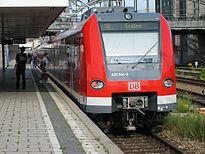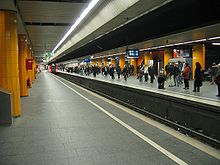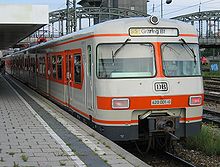- Munich S-Bahn
-
Munich S-Bahn 
S-Bahn train at Hackerbrücke (Br 423)Info Locale Munich Transit type Rapid Transit, Regional rail Number of lines 10 Number of stations 148 Daily ridership 800,000[1] Operation Began operation 28 May 1972 Operator(s) S-Bahn München Technical Track gauge 1,435 mm (4 ft 8 1⁄2 in) (standard gauge) System map The Munich S-Bahn (German: S-Bahn München) is an electric rail transit system in Munich, Germany. "S-Bahn" is the German abbreviation for stadtschnellbahn (literally, "urban rapid [rail]road"), and the Munich S-Bahn exhibits characteristics of both rapid transit and commuter rail systems.
The Munich S-Bahn network is operated by S-Bahn München, a subsidiary of DB Regio Bayern that is itself a subsidiary of the German national railway. It is now integrated into the Munich Transport and Tariff Association (Münchner Verkehrs- und Tarifverbund, MVV) and interconnected throughout the city with the locally-owned Munich U-Bahn. Today, the S-Bahn covers most of the populated area of the Munich Metropolitan area of about 2.7 million inhabitants.
The Munich S-Bahn was established on 28 May 1972. It was intended as part of the scheme to provide an adequate transportation system during the 1972 Summer Olympics held in Munich by connecting the preexisting suburban rail services in the west and east of the city via a new tunnel section from Hauptbahnhof to München Ost station (Ostbahnhof).
Contents
Lines
System
The network has seven branches in the West that are linked to the five branches in the east due to technical requirements.
In addition, the two lines not going through the core route tunnel have two-digit numbers like S2x. Further, the non-electrified line to Altomünster is called line A.
Frequency
The basic interval of the Munich S-Bahn is one train every 20 minutes. On parts of some branches during peak hours there is a 10 minute frequency produced by added trains. A special case is the line to Erding, where on weekdays a mix of express trains from Erding and normal S-Bahn trains from Markt Schwaben runs in the morning peaks, producing a 10 minute frequency west of Munich East station. There are also occasional additional trains on the western section of the S4 and on the S1 between Freising and Munich during the peak hour, which do not continue past the Hauptbahnhofrun through the trunk line tunnel.
Routes
The S-Bahn partly operates on its own routes (one or two tracks), parts of it are double-track lines where S-Bahn operations are mixed with other traffic (passengers and freight), and in some cases more than two tracks are available. In the latter case one-or two tracks are set aside for the S-Bahn operations only and the two other tracks are used for the remaining traffic.
In the following table, the route length is shown from Munich Hauptbahnhof or from Ostbahnhof (Munich East station) because it reflects the chainage officially applied to the lines. An exception is S27 where the chainage starts at Pasing.
Line Route and
sectionDistance from Hbf or Ostbf Other traffic Infrastructure  to
to 
Trunk line
Pasing–Hbf–Ostbahnhof11.4 km Between Pasing and Hauptbahnhof some trains are operated between Donnersbergerbrücke and Hauptbahnhof by Bayerische Oberlandbahn Three stations with three or more platform tracks, three stations using Spanish solution.  West
WestMunich–Regensburg railway
Laim–Freising40.7 km Regional and Interregional (ALEX, DIEX) services, as well as freight traffic. Two tracks in mixed operation for 34.5 km.  West
WestNeufahrn curve
Neufahrn–Airport West (7.3 km)40.8 km S-Bahn only, except for occasional freight trains Two tracks.  West
WestMunich–Ingolstadt line
Laim–Petershausen36.4 km Intercity-Express services to Berlin and Hamburg as well as Frankfurt via Nuremberg, Regional services to Nuremberg and Ingolstadt and freight traffic. Separate S-Bahn (one or two tracks) in addition to high-speed tracks for ICE and other traffic.  West
WestMunich–Augsburg railway
Pasing–Mammendorf31.0 km Regional, long-distance and freight traffic. This is one of the busiest lines in Germany, so it was upgraded to four tracks for the S-Bahn. Separate tracks for the S-Bahn (two to Maisach, then one to Mammendorf).  West
WestAllgäu Railway
Pasing–Geltendorf42.1 km Various regional services every two hours, two hourly EuroCity service to Zürich, diverted long distance services from Augsburg-Munich line Two tracks mixed operations for 34.7 km. Electrified for the S-Bahn to Geltendorf.  West
West
Pasing–Herrsching38.3 km Only S-Bahn services. Two tracks to Weßling, then single track.  West
WestMunich–Garmisch-Partenkirchen railway
Pasing–Tutzing39.6 km Regional services and occasional long distance trains to Garmisch-Partenkirchen. Two separate S-Bahn tracks to Gauting, then two tracks in mixed operation.  West
WestIsar Valley Railway
Solln–Wolfratshausen31.3 km Only S-Bahn services. Two tracks to Höllriegelskreuth, then single track.  East
EastAirport line
Ostbahnhof–Ismaning–Airport33.1 km Freight traffic between Daglfing and North Ring. Continuous two tracks, some in mixed operation with freight.  East
EastMunich–Mühldorf railway
Ostbahnhof–Markt Schwaben–Erding34.7 km Freight and regional traffic towards Mühldorf and Freilassing to Markt Schwaben, then only S-Bahn traffic. Two tracks in mixed operation to Markt Schwaben, then single track to Erding.  East
EastMunich–Salzburg railway and Grafing–Wasserburg railway
Ostbahnhof–Grafing–Ebersberg31.0 km Regional services to Rosenheim and Wasserburg, long distance services to Salzburg, as well as freight traffic. Four tracks to Grafing (S-Bahn operations separated), then single track with mixed traffic.  East
East
Giesing–Kreuzstraße30.1 km S-Bahn only. Single track.  East
East
Ostbahnhof–Giesing–Deisenhofen–Holzkirchen31.2 km S-Bahn only to Deisenhofen. The Bayerische Oberlandbahn also operates between Deisenhofen and Holzkirchen. Two tracks. 
Sendling connection
Pasing–Mittersendling (8.7 km)38.8 km (from Pasing) Runs in part over freight tracks to/from Munich Laim marshalling yard. Single track to Mittersendling, then continuning on Bavarian Maximilian's Railway. 
Bavarian Maximilian's Railway
Hbf–Holzkirchen36.5 km Regional services of the Bayerischen Oberlandbahn. Two tracks in mixed operations. Current S-Bahn lines
(*) Terminus of additional services during peaks. Up to here 10 minute frequency in peaks.
(+) Occasional additional services to create 10 minute frequency.Intra-Urban Long-Distance Lines
The little known connection between the Ostbahnhof and the Hauptbahnhof, called the "Suedring" runs south from Ostbahnhof, bends westward, passing over Kolumbusplatz, the Isar river, Poccistraße and Heimeranplatz to arrive at the Hauptbahnhof without any stops in between. Trains travelling on this route (DB50) are included in the MVV tariff scheme and offer a view of the city in only slightly more time than in the Stammstrecke tunnel.
Additional regional lines make calls at stations also served by the S-Bahn, but provide an effective skip-stop/express functionality for MVV patrons. Examples include:
- Garmisch-Partenkirchen to Munich, calling at Tutzing (S6) and Pasing (Stammstrecke)
- Augsburg to Munich, calling at Mammendorf (irregularly) and Pasing (Stammstrecke)
- Regensburg to Munich, calling at Moosburg, and Freising (S1)
- Rosenheim to Munich, calling at Grafing Bf (S4) and Ostbahnhof (Stammstrecke)
- Various southern lines of the BOB, calling at Holzkirchen (S3), and regional variants from Rosenheim calling at Kreuzstraße (S6) and Holzkirchen (S5) through Großhesselohe
- Lindau to Munich, calling at Geltendorf (S4)
- Nürnberg to Munich, calling at Petershausen (S2) and Dachau Bf (S2)
Expansion plans announced by the MVV include a series of "Express S-Bahns" dedicated skip-stop lines that would operate through the second planned "Stammstrecke."
History
Munich S-Bahn trunk line Route number: 999 Line number: 5540 (Pasing–Hbf (low level))
5550 (Hbf (low level)–Ostbahnhof)Line length: 11.4 Voltage: 15 kV, 16.7 Hz AC Maximum incline: 4.0 % Maximum speed: 120 Legend
S3, S4, S6, S8 
0.0 Pasing 
Separation of S1 and S2 
3.3 Laim 
4.5 Hirschgarten 
Separation of S7, S27 and BOB 
5.8 Donnersbergerbrücke 
Separation of S27 and BOB 
6.6 Hackerbrücke 

7.4 Hauptbahnhof (tief) 
7.9 Karlsplatz (Stachus) 
8.7 Marienplatz 
9.4 Isartor 
10.3 Rosenheimer Platz 

Separation of S3 and S7 
11.4 München Ost 
S2, S4, S6, S8 An underground railway line for Munich was first proposed in 1928 in a report on the "relocation of traffic centres". An underground route would allow "direct long distance traffic to and through the city centre".
On 22 May 1938, the first tunnel, which was part of the north-south route, was started in the Lindwurmstraße, between the present-day underground stations Sendlinger Tor and Goetheplatz. In the speech of Julius Dorpmüller, the general director of Deutsche Reichsbahn, the project was called "S-Bahn" for the first time. Due to World War II the construction and plans for the Munich S-Bahn were set aside.
In 1965, the Federal Republic of Germany, the Free State of Bavaria, the state capital of Munich and the Deutsche Bundesbahn signed a contract on the construction of the Munich S-Bahn. The further development was most influenced by a decision made in Rome on 26 April 1966: The International Olympic Committee chose Munich over Detroit, Madrid and Montreal as the scene for the 1972 Summer Olympics. This resulted in a tight schedule: There were only six years to complete the Munich S-Bahn network.
Not only did the tunnel through the city centre have to be built, the full railway infrastructure had to be expanded. The network of suburban lines had to be changed over and modernized. A large number of stations had to be upgraded; the platforms were brought to a length of 210 m to allow for three-unit trains; the platform height was raised to 76 cm. However, the floor height of the trains used then and now is at ca. 1 m, which makes boarding difficult for people with wheelchairs or prams. Tunnel stations and platforms updated recently where no freight trains run feature a height of 96 cm, however.
On 25 February 1971 the topping-out ceremony could be celebrated in the core route tunnel. In May the first S-Bahn train of the ET 420 series was put into service on the route between Pasing and Gauting. On 1 September 1971 a regular advance service was started on that route.
On 28 May 1972, the Munich S-Bahn network was finally put into service with 360 km of tracks and 101 trains of the ET 420 series. It was the first time a S-Bahn network that size was put into service on a single date. The route S10 to Wolfratshausen (today S7) was operated with conventional push-pull trains from the southern wing of Munich Central Station. It was electrified later and connected to the core route after the construction of a 260 m tunnel crossing the large number of mainline rail tracks leading to Munich Central Station.
Three months later the German President Gustav Heinemann opened the 1972 Summer Olympics. During the Games there were two additional S-Bahn lines servicing the now-defunct station Olympiastadion (Olympic Stadium). The new S-Bahn system stood the test and transported 3.18 million passengers in 7,138 runs to and from the sports sites in only 17 days.
Since then the Munich S-Bahn network has been expanded multiple times. In 1992, the route between Ismaning and the newly opened Airport Munich II has been put into service. Until 2005, there was a 266 million Euro programme to substantially extend the infrastructure. For example, the route Giesing-Deisenhofen has been upgraded with a second track. Since 2000, trains of the type series ET 420 have been gradually replaced by ET 423 trains.
Further dates:
- 15 June 1966 - Construction of the core route tunnel begins in Arnulfstraße.
- 28 April 1972 - first test runs on the tunnel route (Hauptbahnhof-Marienplatz-Ostbahnhof).
- 28 May 1972 - regular service with 360 route km begins.
Rolling stock
No longer in service:
- ET 420 ("Olympia train", 1972 to 2004)
Trialled:
- In 1989, the double decker trains used in the Netherlands were briefly used on the then S4 between Geltendorf and Ebersberg. Patrons were invited to fill out a questionnaire while onboard describing their experiences while boarding and riding the train. The concept was to increase passenger capacity at the same time as accommodating bicycles, prams, and wheelchairs with efficiency. The trains were pulled by a DB Class 120 locomotive at each end of the train.
Plans and further expansions
Current plans for further expansion include the following: [2]
- Second core route: Nearly all lines use the core route, creating a bottle-neck responsible for long delays from even the smallest disruptions. A second tunnel through the city centre is planned, which will be about 10 km (6 mi) in length and which is supposed to be finished in 2025. It will start between the stations Laim and Donnersbergerbrücke and lie north of the current tunnel. Just before Munich East it will fork, with one fork going to Munich East and the other to Leuchtenbergring. In between, only two stations, Central Station and Marienhof (slightly north of Marienplatz), are planned. The tunnel was chosen over another variant to build an S-Bahn along the railway "south ring".
- Extension of S7 to Geretsried (Geretsried Süd railway station) via Gelting and Geretsried Mitte. (Currently in Planning / On Hold)
- Erding ring: connection of the ends of S1/S8 (airport) and S2 East (Erding) (planned, by 2016/2020)
- Possible relocation of the S2 East to the Munich International Trade Fair site with station (Messestadt-Nord?)
- Upgrade of the Sendling Connection Route between Pasing and Heimeranplatz.
- New station Menterschwaige between Solln and Deisenhofen (S20, S27).
- Electrification of Line A between Dachau and Altomünster (by 2012)
Literature
- Popischil, Reinhard; Rudolph, Ernst (1997) (in German). S-Bahn München. Düsseldorf: Alba. ISBN 9783870943585. OCLC 42476820.
- Armin Franzke: Im Tunnel unter City und Isar. 1972: Die S-Bahn München nimmt den Betrieb auf. In: LOK MAGAZIN. Nr. 251/Jahrgang 41/2002. GeraNova Zeitschriftenverlag GmbH München, ISSN 0458-1822, OCLC 3136408, pages 90–97.
- Korhammer, Klaus-Dieter; Franzke, Armin; Rudolph, Ernst (1991) (in German). Drehscheibe des Südens Eisenbahnknoten München. Darmstadt: Hestra Verlag. ISBN 3-7771-0236-9.
- Wilhelm-Stempin, Nikolaus (2009) (in German). S-Bahnhöfe in und um München. Norderstedt: BoD. ISBN 978-3-8391-0927-4.
See also
References
- ^ http://www.s-bahn-muenchen.de/public_main_modul.php?bm=&ses=&page_id=84&document_id=77&unit=4b50472da2eac
- ^ "Regional transport plan" (in German) (PDF: 6.51 MB). MVV. June 2007. http://www.mvv-muenchen.de/web4archiv/objects/download/3/regionalernahverkehrsplanfortschreibung2007final.pdf. Retrieved 6 January 2010.
External links
- S-Bahn München GmbH - Official Site (German)
- Interessengemeinschaft S-Bahn München e.V. (German)
- Fahrgastverband PRO BAHN zur Münchner S-Bahn (German)
- tunnelaktion.de - Alternative concepts for the Munich S-Bahn / Description of alternatives to the second city tunnel from the years 2001-2007
- Flash animation of the concept Teilausbau Südring (upgrade of southern rail connector for S-Bahn lines) - Details for one of the concepts presented on www.tunnelaktion.de
S-Bahn systems in Germany Operating systems Planned and former systems Augsburg | Erfurt (1976-1993)Categories:
Wikimedia Foundation. 2010.





